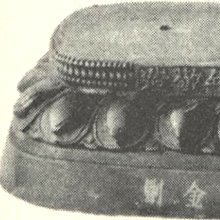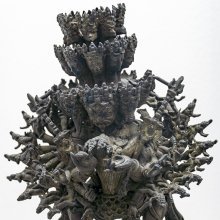Raga, Rāga, Ragā, Rāgā: 58 definitions
Introduction:
Raga means something in Buddhism, Pali, Hinduism, Sanskrit, Jainism, Prakrit, the history of ancient India, Marathi, Hindi, biology. If you want to know the exact meaning, history, etymology or English translation of this term then check out the descriptions on this page. Add your comment or reference to a book if you want to contribute to this summary article.
Raga has 56 English definitions available.
Images (photo gallery)
Languages of India and abroad
Sanskrit dictionary
[Deutsch Wörterbuch]
Source: Cologne Digital Sanskrit Dictionaries: Böhtlingk and Roth Grosses Petersburger WörterbuchRāga (राग):—und rāga (von raj, rañj)
1) m. [Pāṇini’s acht Bücher 6, 4, 27. 1, 216. 159,] [Scholiast] [Vopadeva’s Grammatik 8, 133. 26, 174.] am Ende eines adj. comp. f. ā [Spr. 3180.] [Raghuvaṃśa 17, 44.] [Ṛtusaṃhāra 5, 11.] [Śākuntala 175.] [Varāhamihira’s Bṛhajjātaka S. 78, 15.] [Kathāsaritsāgara 21, 76. 38, 121.] [Pañcatantra 203, 5.] ī gaṇa bahvādi zu [Pāṇini’s acht Bücher 4, 1, 45.] a) das Färben: mūrdhaja [Varāhamihira’s Bṛhajjātaka S. 77, 1.] caraṇaṃ nirmitarāgam [Kumārasaṃbhava 4, 19.] Bez. eines best. Processes, dem das Quecksilber unterworfen wird, [Oxforder Handschriften 320,a,14.] [SARVADARŚANAS. 100,6.] — b) Farbe [Trikāṇḍaśeṣa 3, 3, 68.] [Hemacandra’s Anekārthasaṃgraha 2, 46.] [Medinīkoṣa g. 20.] [Harivaṃśa 4472.] [Rāmāyaṇa Gorresio 1, 76, 4.] [Suśruta 2, 317, 14. fg. 318, 5.] [Raghuvaṃśa 2, 15. 5, 72. 7, 7. 10, 19. 16, 59.] [Kumārasaṃbhava 3, 30.] [Ṛtusaṃhāra 1, 5. 6, 5.] [Meghadūta 33. 103.] [Śākuntala 20. 175. ad 14.] [Spr. 1920.] [Varāhamihira’s Bṛhajjātaka S. 12, 19. 77, 36.] [Kathāsaritsāgara 23, 78. 24, 178.] [Mārkāṇḍeyapurāṇa 51, 36.] Farbe und zugleich Leidenschaft [Spr. 3810.] — c) Röthe [Amarakoṣa 1, 1, 4, 25.] [Trikāṇḍaśeṣa] roṣa [Mahābhārata 3, 15639.] [Suśruta 1, 34, 16. 37, 2. 38, 14.] raso rāgamupaiti wird roth [43, 13. 69, 16. 2, 304, 7.] [Spr. 622. 2673. 3555. 4933.] [Kumārasaṃbhava 5, 11.] [Vikramorvaśī 26.] Röthe und zugleich Leidenschaft, Zuneigung [Spr. 472. 2831. 3180. 3807.] [Pañcatantra 203, 5.] [Naiṣadhacarita 22, 55.] — d) Nasalirung [Prātiśākhya zum Ṛgveda 11, 19. 14, 24.] viṣamarāgatā [4.] — e) Reiz, Lieblichkeit (der Stimme, des Gesanges): gīta [Śākuntala 5. 4, 11.] aho rāgaparivāhinī gītiḥ [59, 11.] surāgasvareṇa [Pañcatantra 213, 1.] upanītarāgatvam (vācaḥ) [Hemacandra’s Abhidhānacintāmaṇi 66.] — f) eine musikalische Weise, deren [6] angenommen werden (Bhairava, Kauśika, Hindola, Dīpaka, Śrirāga und Megha, oder Śrīrāga, Vasanta, Pañcama, Bhairava, Megha und Naṭanārāyaṇa, oder Mālava, Mallāra, Śrīrāga, Vasanta, Hillola und Karṇāṭa); sie werden personificirt und jedem werden [5] oder [6] Rāgiṇī und [8] Söhne zugetheilt, [Śabdakalpadruma] [Oxforder Handschriften 199,b, No. 471. 200,a,4 v. u. b,14. fg. 201,b, No. 481.] [Weber’s Verzeichniss No. 1384.] [Rājataraṅgiṇī.5,362.] [PAÑCAR.1,11,3.] [Pañcatantra 248,6.] [ŚUK.] in [Lassen’s Anthologie (III) 33,5.] grāmarāgāḥ sapta [Mārkāṇḍeyapurāṇa 23, 51.] [PAÑCAR. 3, 5, 36.] rāgāḥ (so [BÜHLER] st. varṇāḥ) ṣaḍviśatiḥ [Pañcatantra V, 44 (55] [BÜHLER][?). Nach Hemacandra’s Anekārthasaṃgraha und Medinīkoṣa] eine musikalische Note (gāndhārādi). — g) Leidenschaft, heftiges Verlangen nach Etwas, Sympathie, Zuneigung, Liebe, Freude an; = kleśādi (s. weiter unten) [Trikāṇḍaśeṣa] [Hemacandra’s Anekārthasaṃgraha] [Medinīkoṣa] = anurāga [Hemacandra’s Abhidhānacintāmaṇi 296.] [Hemacandra’s Anekārthasaṃgraha] [Medinīkoṣa] = rasa [Amarakoṣa 3, 4, 30, 229.] [Halāyudha 5, 75.] = mātsarya, matsara [Trikāṇḍaśeṣa] [Hemacandra’s Anekārthasaṃgraha] [Medinīkoṣa] = gṛdhnutā [Trikāṇḍaśeṣa 1, 1, 131.] Gegens. virāga, vairāgya [Kapila 2, 9.] [SĀṂKHYAK. 45.] [Bhāgavatapurāṇa 1, 9, 26.] aparāga [Spr. 4934.] [KĀM. NĪTIS. 12, 8.] dveṣa [Manu’s Gesetzbuch 6, 60. 12, 26.] [Bhagavadgītā 3, 34.] [ŚĀṆḌ. 6.] [Spr. 4603.] [Rājataraṅgiṇī 1, 7. 3, 329.] [Bhāgavatapurāṇa 5, 14, 27.] [Hemacandra’s Abhidhānacintāmaṇi 73.] [SARVADARŚANAS. 115, 11. 167, 13. 15.] avidyatāsmitārāgadveṣābhiniveśāḥ pañca kleśāḥ [Mallinātha] zu [Śiśupālavadha 4, 55.] rāgaroṣau [Spr. 1314. -] [Muṇḍakopaniṣad 1, 2, 9.] [MAITRYUP. 3, 5.] [Yājñavalkya’s Gesetzbuch 2, 4.] kāmarāgavivarjita [Bhagavadgītā 7, 11.] [Harivaṃśa 4474.] [Kapila 3, 30. 4, 9. 25. 27.] [KAṆ. 6, 2, 10.] [ŚĀṆḌ. 57.] [Raghuvaṃśa 16, 60. 17, 44.] [Ṛtusaṃhāra 5, 11. 6, 23.] [Spr. 2594. fgg. 2717. 2881. 3729. 3961. 4452. 5110.] [Varāhamihira’s Bṛhajjātaka S. 78, 15. 106, 5.] [Kathāsaritsāgara 21, 76. 27, 22. 37, 28. 38, 121.] [Rājataraṅgiṇī 1, 271.] ceṣṭā rāgānugāḥ [?3, 513. 518. 4, 26. fg. 5, 369. 6, 74. 83. 297. 333. Bhāgavatapurāṇa 5, 18, 14. Prabodhacandrodaja 13, 10. Pañcatantra 29, 17. Daśakumāracarita in Benfey’ Chrestomathie aus Sanskritwerken 197, 5.] rāga, kāma, icchā, tṛṣṇā [Spr. 2596.] sneharāgāpanayana [KĀM. NĪTIS. 17, 8.] rāgāndha [MAITRYUP. 4, 2.] [Spr. 778.] [Rājataraṅgiṇī 1, 255. 5, 386.] grahagṛhīta [4, 676.] kṣīṇa [Amarakoṣa 3, 4, 15, 90.] gaṇḍasthalasthamadavāriṣu baddharāgamattabhramadbhramaraḥ [Spr. 812.] saṃjīvakanibaddha [Pañcatantra 58, 13.] tathā tathāsya vai dyūte rāgo bhūyo bhivardhate [Mahābhārata 3, 2285.] guṇeṣu [Spr. 859.] sukhe [Bhāgavatapurāṇa 6, 17, 22.] naiṣadhe [Mahābhārata 3, 2213. 14125.] [Mārkāṇḍeyapurāṇa 62, 14.] tadrāgāt [Rāmāyaṇa 2, 60, 19. 5, 51, 10.] yuddharāgāt [Harivaṃśa 5056.] svadeśarāgeṇa [Spr. 2448.] viṣayopabhogarāgāt [KĀM. NĪTIS. 7, 35.] darśanābhyāsasaṃvṛddhacakṣūrāga Augenlust [Rājataraṅgiṇī 5, 382.] prāptiḥ prayogasya (increase of the interest of the performance [BALL.]) [Sāhityadarpana 407.] [Kumārasaṃbhava 7, 91.] Leidenschaft, Zuneigung und zugleich Farbe, Röthe [Spr. 472. 2831. 3807. 3810.] — h) Fürst, König [Hemacandra’s Anekārthasaṃgraha] [Medinīkoṣa] — i) die Sonne; der Mond [Śabdaratnāvalī im Śabdakalpadruma] —
2) f. ā a) Eleusine coracana Pers. [Rājanirghaṇṭa] bei [WILSON.] — b) Nomen proprium der 2ten Tochter des Aṅgiras (vgl. rākā) [Mahābhārata 3, 14125.] — Vgl. aṅgarāga (auch [Prabodhacandrodaja 49, 1]), guṇa (auch [Kathāsaritsāgara 12, 25]), citta, taru, ni, nīlī, padma, pika, pīta, puṣpa, bhakti, mañjiṣṭhā, maṇi, mada, mukha, vīta, sa, saṃdhyā, haridrā .
Source: Cologne Digital Sanskrit Dictionaries: Sanskrit-Wörterbuch in kürzerer FassungRāga (राग):——
1) m. (adj. Comp. f. ā und ī) — a) das Färben. — b) ein best. Process , dem das Quecksilber unterworfen wird. — c) Farbe. — d) Röthe. Auch so v.a. Entzündung [Carakasaṃhitā 6,30.] — e) Nasalirung. — f) Besitz , Lieblichkeit (der Stimme , des Gesanges). — g) eine musikalische Weise (deren 6 , 7 und 26 angenommen werden). Auch personificirt. — h) *eine musikalische Note. — i) Leidenschaft , heftiges Verlangen nach Etwas , Sympathie , Zuneigung , Liebe , Freude an die Ergänzung im Loc. oder im Comp. vorangehend. — k) Würze [Carakasaṃhitā 6,12.] — l) *Fürst , König. — m) *die Sonne. — n) *der Mond. —
2) f. ā — a) *Eleusine coracana. — b) Nomen proprium einer Tochter Aṅgiras. —
3) *f. ī = 2)a) [Materia medica of the Hindus 314.]
Sanskrit, also spelled संस्कृतम् (saṃskṛtam), is an ancient language of India commonly seen as the grandmother of the Indo-European language family (even English!). Closely allied with Prakrit and Pali, Sanskrit is more exhaustive in both grammar and terms and has the most extensive collection of literature in the world, greatly surpassing its sister-languages Greek and Latin.
See also (Relevant definitions)
Starts with (+188): Raga Sutta, Ragaba, Ragabandha, Ragabandhin, Ragabhanjana, Ragabhava, Ragabija, Ragacandrodaya, Ragacarita, Ragacchanna, Ragachanna, Ragacharita, Ragachchhanna, Ragachhanna, Ragachikitsa, Ragachurna, Ragacikitsa, Ragacitta, Ragacudamani, Ragacurna.
Ends with (+409): Abhiparaga, Abhipraga, Abhraga, Accheraga, Adavibooraga, Adaviburaga, Adhararaga, Adhvaraga, Agaraga, Agraga, Aharaga, Ahibhanuraga, Ahiraga, Ajbhoyaraga, Ajnanaraga, Akaraga, Alaktakaraga, Alaktaraga, Ambaraga, Amgajaraga.
Full-text (+1084): Shriraga, Angaraga, Tambularaga, Natanarayana, Ragabandha, Vitaraga, Ragavrinta, Ragamala, Pushparaga, Ragacurna, Anyadraga, Ragini, Manjishtharaga, Ragarajju, Viraga, Ragalata, Cittaraga, Panduraga, Ragalakshana, Lobha.
Relevant text
Search found 146 books and stories containing Raga, Rāga, Ragā, Rāgā; (plurals include: Ragas, Rāgas, Ragās, Rāgās). You can also click to the full overview containing English textual excerpts. Below are direct links for the most relevant articles:
Garga Samhita (English) (by Danavir Goswami)
Verses 2.20.34-37 < [Chapter 20 - The Rāsa-dance Pastime]
Verse 5.21.30 < [Chapter 21 - The Story of Śrī Nārada]
Verse 5.21.29 < [Chapter 21 - The Story of Śrī Nārada]
Sahitya-kaumudi by Baladeva Vidyabhushana (by Gaurapada Dāsa)
Text 10.251 < [Chapter 10 - Ornaments of Meaning]
Text 10.170 < [Chapter 10 - Ornaments of Meaning]
Text 4.16 < [Chapter 4 - First-rate Poetry]
Musical Compositions of Muthuswami Dikshitar on Planets < [April – June, 1982]
Studies in Rajput Painting: I. Raga-Ragini Series < [May-June, 1929]
Muthuswami Dikshita < [January – March, 1987]
The Brihaddharma Purana (abridged) (by Syama Charan Banerji)
Samkhya thoughts in the Mahabharata (by Shini M.V.)
Vidyā and Avidyā in Yoga Philosophy < [Chapter 3 - The Philosophical Tenets in the Śānti-parva]
Bhakti-rasamrta-sindhu (by Śrīla Rūpa Gosvāmī)
Verse 3.5.26 < [Part 5 - Conjugal Love (mādhurya-rasa)]
Verse 3.2.87 < [Part 2 - Affection and Service (dāsya-rasa)]
Verse 1.2.272 < [Part 2 - Devotional Service in Practice (sādhana-bhakti)]
Related products








